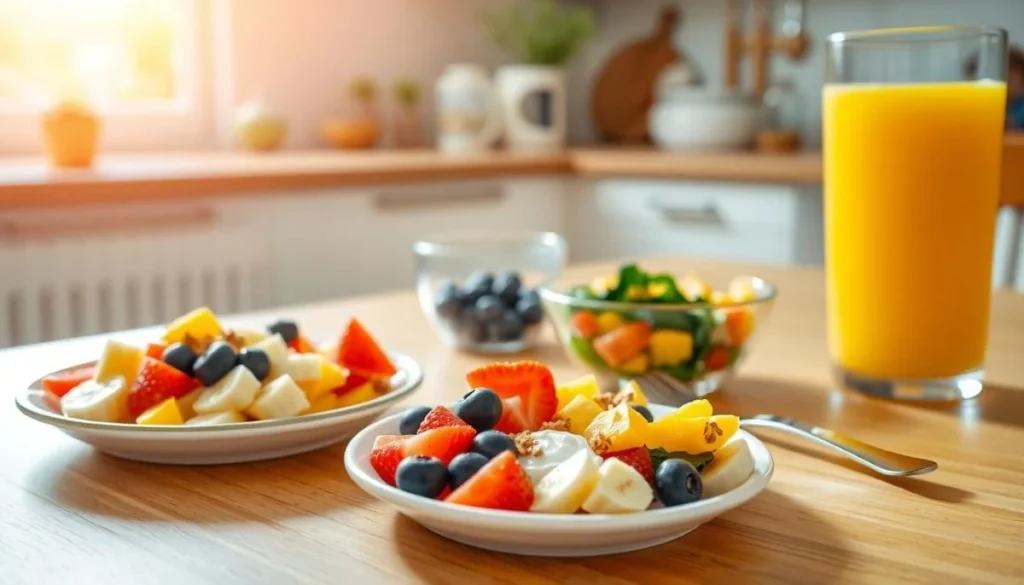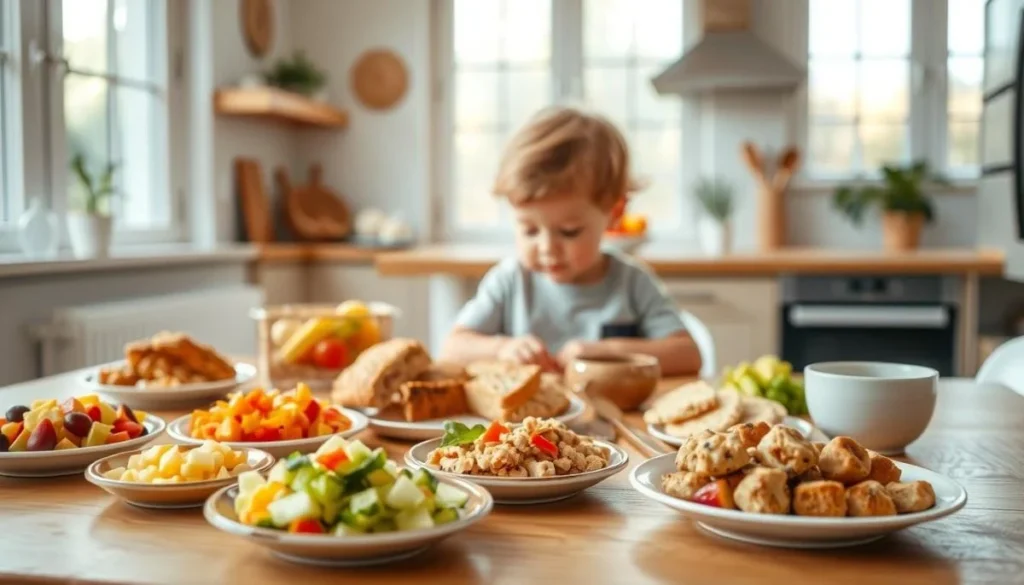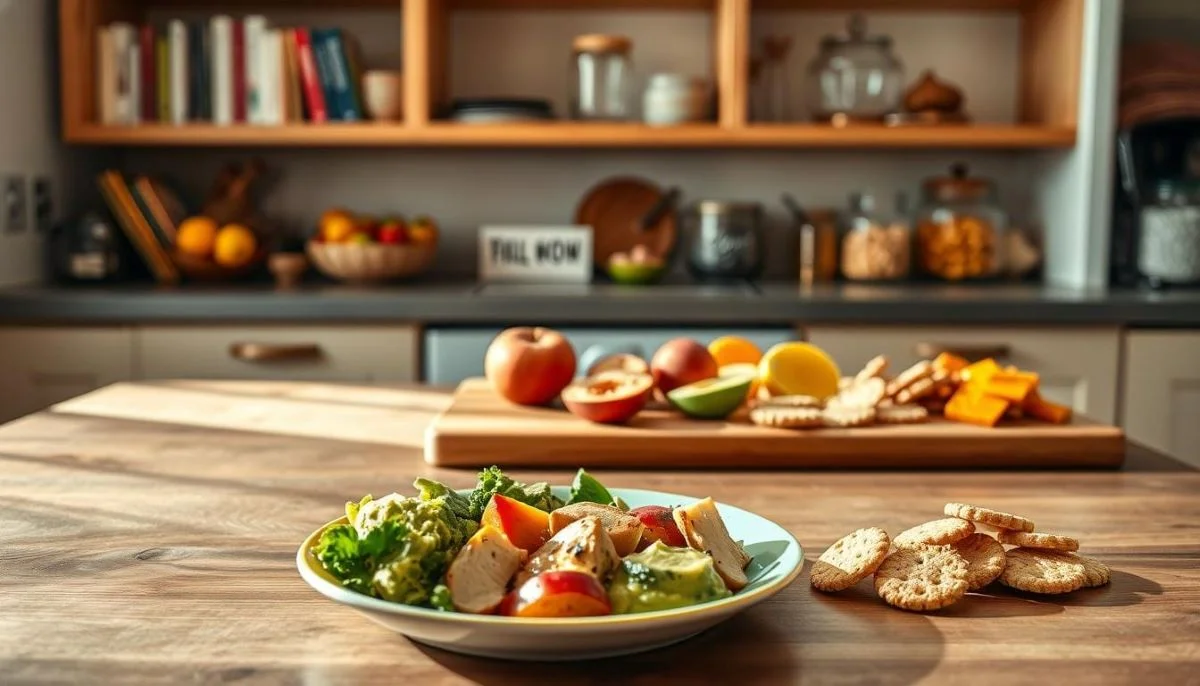Healthy Meal Ideas for 14 Month Old | Toddler Nutrition
Every parent faces the challenge of finding healthy meal ideas for 14 month old. Staring into the fridge, wondering what your little one will eat, can be tough. Creating meals for toddlers needs creativity, patience, and a bit of magic.
Your toddler is at a key stage where food is very important. Healthy meals aren’t just for filling bellies. They help with growth, brain development, and good eating habits. By choosing colorful, fun meals, you can make mealtime exciting.
Toddlers love to explore, and their food should too. They need a mix of proteins, fats, and carbs for energy. Our guide will show you how to make every meal count.
We’ll share ideas for breakfast, snacks, and more to keep your 14-month-old happy and healthy. You’ll find tasty, safe recipes that everyone will enjoy.
Essential Nutrients for 14-Month-Old Development
Nutrition is key for your toddler’s growth. At 14 months, they need a balanced diet for physical and mental growth. Knowing the important nutrients helps you plan a good 14 month old feeding schedule.
Your toddler’s diet should have essential nutrients for healthy growth. Baby-led weaning meals are great for introducing a variety of foods that offer these nutrients.
Proteins and Healthy Fats for Growth
Protein is vital for your toddler’s body growth. They should get:
- 2 servings of protein (about 200 calories)
- Lean meats, eggs, and beans are good options
- 1 ounce of meat or 1/2 egg is a serving size
Vitamins and Minerals for Brain Development
For brain growth, specific nutrients are needed. These include:
- Vitamin D: 600 IU daily
- Calcium-rich foods
- Iron-fortified foods
Complex Carbohydrates for Energy
Complex carbs give your toddler lasting energy. Add these to their meals:
- Whole grain cereals
- Brown rice
- Quinoa
- Oatmeal
A 14-month-old needs about 1,000 calories daily. Most of these calories come from solid foods. Choosing nutrient-rich foods supports your toddler’s growth and health.
Understanding Your Toddler’s Nutritional Needs
Figuring out what to feed your 14-month-old can be tricky. Their diet is key to their growth and health. The American Academy of Pediatrics suggests 1000 calories a day, spread out in meals and snacks.
It’s important to know about nutritional basics. Finger foods are great for toddlers to learn to eat on their own. They should get a mix of foods to get all the nutrients they need.
- Fruits: 2-3 servings daily
- Vegetables: 2-3 servings daily
- Grains: 6-11 servings daily
- Protein: 2 servings daily
- Dairy: 2-3 servings daily
How much food you give your toddler matters. Give them about 1/4 of what an adult eats. This helps avoid too much food and ensures they get enough nutrients.
| Nutrient | Daily Serving | Serving Size |
|---|---|---|
| Grains | 6 servings | ½ slice bread, ¼ cup cereal |
| Vegetables | 2-3 servings | 1 tablespoon cooked |
| Protein | 2 servings | 1 ounce cooked meat |
Choose foods that help your toddler’s brain grow. Foods high in iron like beans and lean meats are important. Also, add healthy fats from full-fat dairy, nuts, and salmon for brain health.
Nutrition is not about perfection, but about offering a balanced and varied diet that supports your toddler’s unique developmental needs.
Breakfast Ideas for Growing Toddlers
Start your toddler’s day with healthy morning meals. These meals give them the nutrients they need to grow and stay active. Making breakfast fun can turn mealtime into an adventure for your picky eater.

Quick and Easy Morning Meals
Busy parents need quick, healthy snacks for breakfast. Here are some fast options:
- Yogurt parfaits with fresh berries
- Whole grain toast with mashed avocado
- Scrambled eggs with soft vegetables
Make-Ahead Breakfast Options
Planning ahead saves time and ensures your toddler eats well. Try these make-ahead ideas:
- Overnight oats prepared the night before
- Frozen whole grain pancakes
- Breakfast burritos that can be quickly reheated
Protein-Rich Morning Choices
| Breakfast Item | Protein Content | Additional Benefits |
|---|---|---|
| Greek Yogurt | 15-20g per serving | Supports immune function |
| Scrambled Eggs | 6-8g per egg | Rich in brain-boosting nutrients |
| Nut Butter on Toast | 4-7g per serving | Provides healthy fats |
Toddlers’ appetites change, so offer many healthy foods. Patience and creativity are key when introducing new breakfasts.
Meal Ideas for 14 Month Old
It can be tough to find meal ideas for 14 month olds. They are getting pickier and better at eating. Making your own baby food purees is a great way to give them healthy, tailored meals.
At this age, kids need a mix of nutrients, textures, and tastes. Here are some tips for making tasty, healthy meals:
- Offer small, bite-sized portions
- Incorporate multiple food groups
- Experiment with different textures
- Focus on nutrient-dense ingredients
Here are some nutritious meal ideas for 14-month-olds:
| Meal Type | Suggested Combination |
|---|---|
| Protein-Packed Lunch | Soft-cooked chicken strips, mashed sweet potato, steamed broccoli florets |
| Balanced Dinner | Turkey meatballs, quinoa, roasted vegetable puree |
| Nutrient-Rich Breakfast | Scrambled eggs, whole grain toast, banana slices |
When making homemade baby food purees, start with small amounts of new flavors. Change up the ingredients to keep things interesting and avoid boredom. Cooking in batches can make meal prep easier. This way, you can make lots of food at once and store it for later.
Pro tip: Always watch your toddler while they eat. Cut their food into small pieces to avoid choking.
Smart Snacking Options for Toddlers
Snack time is key to boosting your toddler’s nutrition. Creating healthy baby food recipes and snacks is vital for their growth.
Toddlers need small, packed-with-nutrients meals. The right snacks help keep their energy up and blood sugar stable. They also provide important vitamins and minerals.
Healthy Finger Foods
Finger foods help with fine motor skills and encourage kids to eat on their own. Here are some good options:
- Soft fruit cubes (banana, mango, strawberries)
- Steamed vegetable sticks
- Cheese cubes
- Mini whole grain crackers
- Hard-boiled egg quarters
Nutrient-Dense Snack Combinations
Mixing different foods makes balanced, healthy snacks for your toddler:
- Apple slices with almond butter
- Greek yogurt with berries
- Hummus with vegetable sticks
- Whole grain toast with mashed avocado
Portable Snack Ideas
For families on the go, easy-to-carry snacks are a must. Choose small, nutritious options:
- Homemade mini muffins
- Frozen fruit cubes
- Cheese and whole grain crackers
- Veggie nuggets
Always watch your toddler while they snack. Cut food into small pieces to avoid choking.
Lunch and Dinner Recipes

Making tasty and healthy meals for your 14-month-old can be fun. They are discovering new tastes and textures. Healthy recipes don’t need to be hard or take a lot of time.
Here are some yummy and nutritious meal ideas for your toddler:
- Veggie-packed mini sandwiches
- Colorful quesadillas with hidden vegetables
- Simple pasta dishes with protein
- Mini frittatas with cheese and vegetables
- Soft stir-fry with small protein pieces
When making meals for toddlers, aim for variety. Variety is key to developing healthy eating habits. Try to make balanced plates with proteins, veggies, and whole grains.
| Meal Type | Key Ingredients | Preparation Time |
|---|---|---|
| Mini Quesadillas | Cheese, shredded chicken, spinach | 10-15 minutes |
| Veggie Pasta | Whole wheat pasta, pureed vegetables, mild cheese | 15-20 minutes |
| Protein Packed Frittata | Eggs, cheese, diced vegetables | 20 minutes |
Toddler portions are small, about one-third of an adult’s. Try different textures and tastes to keep meals fun for your child.
Addressing Common Feeding Challenges
Dealing with picky eater toddler meals can be tough for parents. It takes patience and smart strategies to make mealtime work. Understanding your 14 month old’s feeding schedule is crucial.
Dealing with Picky Eating
Toddlers often picky about food, which is normal. Studies show kids need to try new foods many times before they like them. Here are some tips to handle picky eating:
- Offer new foods again and again without forcing them
- Make meals look fun and colorful
- Let your toddler play with different food textures
- Eat together as a family to show good eating habits
Managing Portion Sizes
Toddlers eat much less than adults. They might only eat 2-10 bites at a meal. Here are some portion tips:
| Food Group | Recommended Serving Size |
|---|---|
| Dairy | ½ cup (2-3 servings daily) |
| Proteins | 1-2 tablespoons |
| Vegetables | 2-3 tablespoons |
Creating Consistent Meal Routines
Having a regular eating schedule makes toddlers feel safe. Space out meals and snacks 2-3 hours apart. It’s okay if their appetite changes during this time.
Patience is key: Most children become less selective about food by around age 6.
Food Safety and Preparation Tips
When making healthy baby food, safety and hygiene are key. Focus on keeping your toddler safe by following proper food handling and preparation. This is crucial for their health.
Important food safety tips for toddlers include:
- Wash hands thoroughly before food preparation
- Use clean cutting boards and utensils
- Cook meats and eggs to recommended internal temperatures
- Refrigerate prepared foods within two hours
Safe food storage is crucial for maintaining meal quality and preventing bacterial growth. Use airtight containers for your homemade baby food purees. Label them with the preparation date. Most pureed foods can be safely stored in the fridge for 48-72 hours.
“Careful preparation transforms simple ingredients into nutritious meals for your growing toddler.” – Pediatric Nutrition Expert
When reheating meals, make sure they’re heated evenly. Check the temperature to avoid burns. Always throw away leftover food that’s been partially eaten to avoid contamination.
Here are more safety tips for making healthy baby food:
- Use fresh, high-quality ingredients
- Avoid cross-contamination between raw and cooked foods
- Introduce new foods gradually
- Watch for potential allergic reactions
By following these food safety practices, you’ll make nutritious, safe meals. These meals will support your toddler’s growth and development.
Get picks related to meal ideas for 14 month old:
- Quick & Easy Dinners for 1 Year Old Toddlers
- Tasty Meals Toddlers and Preschoolers Love to Eat
- Healthy Meals for 1 Year Old: Complete Feeding Guide
- 5-Minute Toddler Meals: Healthy & Satisfying Recipes
Conclusion
Toddler meal planning is key for a lifetime of good eating. Starting with baby-led weaning meals makes food time exciting and educational. It helps your 14-month-old learn to love healthy foods.
Being creative and patient is important for good toddler nutrition. It might take 10 tries for a child to like new foods. Adding fruits, veggies, and full-fat dairy to meals gives them important nutrients.
Keep making meal plans varied and balanced. Aim for 40% carbs, 30% fats, and 30% protein. Try new things like lamb curry with rice or mashed sweet potato with chickpeas. This helps your toddler develop good eating habits.
Feeding a toddler can be tough but also very rewarding. Keep a positive attitude, be patient, and enjoy the journey. Your hard work in making meals healthy and tasty will help your child eat well for years to come.
To have an idea about Baby-led weaning visit this link.
FAQ
How much food should a 14-month-old eat per day?
A 14-month-old needs about 1,000-1,400 calories daily. This is spread across three meals and 2-3 snacks. Portion sizes are about 1/4 to 1/2 of what an adult eats. Watch your toddler’s hunger and fullness cues to guide their intake.
What are the most important nutrients for a 14-month-old?
Key nutrients include protein for growth, calcium for bones, iron for the brain, healthy fats for brain development, and complex carbs for energy. A balanced diet with fruits, veggies, whole grains, lean proteins, and dairy is essential.
How can I handle my picky eater?
Offer a variety of foods repeatedly. Present new foods with familiar ones. Make meals fun and involve your toddler in cooking. Avoid forcing them to eat. Be patient, as it may take time for them to accept new foods.
Are homemade purees still appropriate for a 14-month-old?
At 14 months, most toddlers are ready for more textured foods. While some purees are okay, focus on solid foods that encourage self-feeding. Gradually increase food texture to support their eating skills.
What are some safe finger foods for a 14-month-old?
Safe finger foods include soft fruits, steamed veggies, small cheese cubes, scrambled eggs, and soft pasta. Also, small pieces of well-cooked chicken or tofu are good. Always cut foods into small pieces to prevent choking.
How often should I introduce new foods?
Introduce one new food every 3-5 days. This helps monitor for allergies and lets your toddler get used to different tastes and textures. Be patient and keep offering new foods, even if they’re initially rejected.
What foods should I avoid giving my 14-month-old?
Avoid foods that can choke, like whole grapes and large chunks of meat. Also, limit added sugars, excessive salt, and honey. Cut foods into small pieces and always supervise your toddler during meals.
How can I ensure my toddler is getting enough nutrients?
Offer a varied diet with different colors and types of foods. Include proteins, fruits, veggies, whole grains, and dairy. Consider a multivitamin if your pediatrician recommends it. Aim for balance over time, not perfect nutrition every day.
What are good protein sources for a 14-month-old?
Great protein sources include eggs, Greek yogurt, cottage cheese, soft tofu, and ground meat. Also, fish, beans, lentils, and nut butters are good. Include a protein source in most meals to support growth and development.
How do I handle mealtime tantrums and food refusal?
Stay calm and patient. Maintain a consistent routine and offer choices. Make meals fun and engaging. Avoid using food as a reward or punishment. If your toddler refuses a meal, don’t force them to eat. Simply offer the food again at the next meal or snack time.
How did you find our Post?
There are no reviews yet. Be the first one to write one.

